As summer’s warmth fades and crisp autumn air arrives, your gardening journey doesn’t have to end. 🍂 In fact, fall is one of the most rewarding seasons to grow vegetables. With cooler temperatures, fewer pests, and improved plant flavors, the fall garden offers a unique opportunity to extend your harvest well beyond summer.
In this guide, we’ll explore the top vegetables to plant now, along with practical tips, growing requirements, and harvesting advice to help you make the most of your autumn garden. 🌱✨
🥦 1. Broccoli – A Cool-Weather Champion
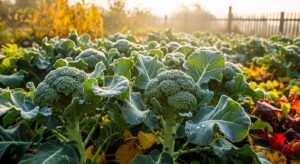
Broccoli thrives when days are mild and nights are cool, making fall the perfect planting season. Sow seeds indoors 6–8 weeks before the first frost, or purchase young transplants for quicker harvests.
✅ Soil Needs: Rich, fertile soil with lots of organic matter.
✅ Harvest Tip: Cut the main head before flowers open, then enjoy smaller side shoots for weeks.
✅ Bonus: Frost actually improves broccoli’s flavor, giving it a sweeter, nuttier taste.
🥬 2. Kale – Frost-Kissed Goodness
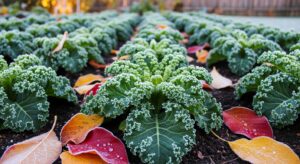
Kale is one of the hardiest leafy greens you can grow. With varieties like curly kale, lacinato (dinosaur), and red Russian, this nutrient powerhouse thrives in cool conditions.
✅ Why Grow in Fall: A touch of frost enhances kale’s flavor, reducing bitterness and adding sweetness.
✅ Harvest Tip: Pick outer leaves first, allowing the plant to keep producing new tender leaves.
✅ Fun Fact: Kale can survive into early winter in many climates, especially with row covers.
🥕 3. Carrots – Sweet, Crunchy Treats
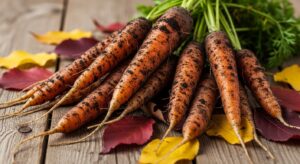
Carrots love the cool soil of fall. Direct sow seeds in loose, sandy soil to prevent deformed roots. Keep the bed moist until seedlings establish.
✅ Harvest Tip: Leaving some in the soil during cold weather makes carrots sweeter.
✅ Variety Picks: Try Nantes or Chantenay for short roots if your soil is heavy.
✅ Pro Tip: Thin seedlings early to avoid crowding and ensure even-sized carrots.
🧄 4. Garlic – Plant Now for Next Year’s Harvest
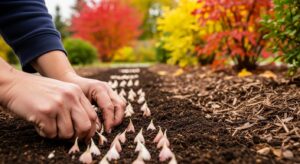
Garlic requires patience, but fall planting pays off with bigger, more flavorful bulbs in late spring or early summer.
✅ How to Plant: Bury individual cloves 2–3 inches deep, pointy end up, and mulch heavily.
✅ Varieties: Hardneck garlic is best for colder regions, softneck for milder climates.
✅ Extra Benefit: Garlic helps deter pests when interplanted with other crops.
🥗 5. Spinach – The Frost-Loving Leaf
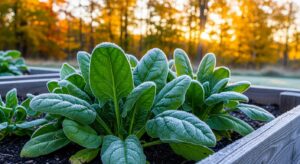
Spinach is a quick-growing crop that thrives in chilly weather. Sow seeds directly in the garden, and enjoy tender young leaves within 3–4 weeks.
✅ Harvest Tip: Cut outer leaves as needed, or harvest the entire plant for a larger yield.
✅ Winter Gardening: In mild climates, spinach can overwinter under protection.
✅ Pro Tip: Sow in succession for continuous harvests through fall.
🥒 6. Radishes – The Speedy Crop
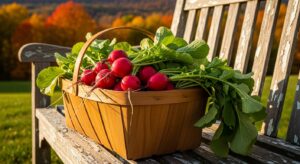
Radishes are the sprinters of the garden—ready to harvest in just 25–30 days. With their peppery crunch, they’re an excellent quick crop for fall.
✅ Varieties to Try: French Breakfast, Cherry Belle, or Daikon for variety.
✅ Pro Tip: Plant in intervals every 2 weeks for a steady supply.
✅ Extra Benefit: Radishes also loosen compact soil for other root crops.
🥬 7. Lettuce – Crisp Fall Greens
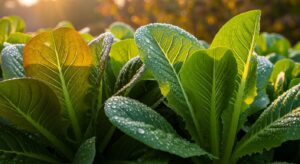
Cool weather prevents lettuce from bolting (flowering), making fall the best time for tender, sweet leaves.
✅ Variety Picks: Romaine, butterhead, or loose-leaf lettuces all perform well.
✅ Harvest Tip: Use the “cut and come again” method to enjoy multiple harvests from one planting.
✅ Pro Tip: Grow under row covers to protect from early frosts and extend your season.
🧅 8. Onions – Plant Now for Spring Rewards
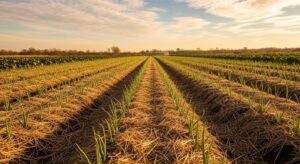
Fall-planted onions grow slowly through winter and reward you with larger bulbs in early summer.
✅ Best Choices: Overwintering varieties or onion sets (small bulbs).
✅ Soil Needs: Loose, fertile soil with good drainage.
✅ Pro Tip: Mulch heavily to protect from harsh frosts and temperature swings.
🥔 9. Potatoes – A Cold-Season Treat
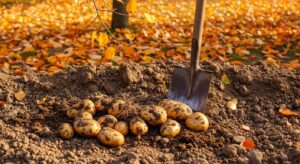
In mild climates, potatoes can be planted in the fall for a late winter or spring harvest. They require nutrient-rich, fluffy soil to thrive.
✅ How to Plant: Bury seed potatoes 4–6 inches deep, eyes facing upward.
✅ Harvest Tip: Hill soil around plants to prevent green, bitter tubers.
✅ Fun Fact: Potatoes can tolerate light frost, but cover them during cold snaps.
🥬 10. Cabbage – A Classic Fall Favorite
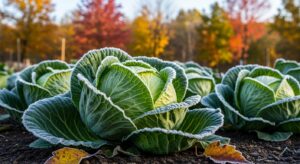
Cabbage thrives in crisp fall weather, forming tight, crunchy heads. With green, red, and savoy varieties, it’s versatile and nutrient-dense.
✅ Harvest Tip: Cut the head at the base when firm; smaller heads may regrow from side shoots.
✅ Pro Tip: Protect from cabbage worms with floating row covers.
✅ Storage: Store harvested heads in a cool cellar for months.
🌰 11. Beets – Root and Leaf Goodness
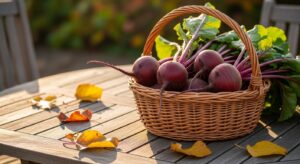
Beets are a dual-purpose crop: enjoy the roots roasted or pickled, and sauté the greens for a nutrient boost.
✅ Fall Advantage: Cooler temps prevent woody roots, keeping them tender.
✅ Harvest Tip: Pull when roots are about 2 inches across for the best flavor.
✅ Pro Tip: Grow colorful varieties like golden or chioggia for a vibrant plate.
🥦 12. Cauliflower – The Tricky But Rewarding Crop

Cauliflower can be fussy, but fall conditions are perfect for it. It prefers steady cool weather and requires fertile, moist soil.
✅ Harvest Tip: When heads reach full size but before yellowing, cut at the base.
✅ Pro Tip: Tie outer leaves over the head (“blanching”) to keep it white and tender.
✅ Bonus: Purple and orange varieties add color and extra nutrients.
🌿 Why Plant a Fall Garden?
-
🌤️ Cooler Days, Happier Plants: Less heat stress compared to summer.
-
🐞 Fewer Pest Problems: Many summer bugs die off with cooler weather.
-
🍴 Fresh Food When Stores Get Expensive: Save money and eat fresh.
-
❄️ Season Extension Possibilities: Use row covers or cold frames for harvests well into winter.
🍂 Final Thoughts
A fall garden is not just an afterthought—it’s a secret weapon for gardeners who want fresh food, beautiful beds, and extended harvests. From quick crops like radishes to long-haul growers like garlic and onions, planting now ensures that your garden stays alive, colorful, and productive well past summer. 🌱✨
So, grab your tools, prep your soil, and dive into this fall garden frenzy. Your table—and your taste buds—will thank you. 🥬🥕
❓ 10 FAQs About Fall Gardening Vegetables
1. What vegetables grow best in the fall?
Leafy greens like kale, spinach, and lettuce thrive in cool weather, while root crops such as carrots, beets, and radishes also perform well. Garlic and onions are great to plant now for a spring harvest.
2. When should I start planting fall vegetables?
Most fall crops should be planted 6–8 weeks before your area’s first expected frost date. Root vegetables like carrots and beets should be sown earlier, while greens can be planted closer to frost.
3. Can fall vegetables survive frost?
Yes! Many fall vegetables like kale, spinach, and carrots actually taste sweeter after a light frost. Some crops, such as cabbage and broccoli, tolerate frost very well.
4. Do I need to cover my fall vegetables?
Not always. However, using row covers, cold frames, or mulch can help protect plants from early frosts, extend the growing season, and shield them from pests.
5. Is fall gardening better than spring gardening?
In many ways, yes! Fall gardens face fewer pest problems, cooler temperatures, and crops like carrots and kale are sweeter after frost. The soil often retains moisture better, too.
6. What’s the fastest vegetable to grow in the fall?
Radishes are the quickest they’re ready to harvest in just 25–30 days, making them perfect for fall succession planting.
7. Can I grow potatoes in the fall?
In mild climates, yes. Plant potatoes in the fall for a late winter or early spring harvest. In colder regions, they’re best planted in spring.
8. How do I prepare soil for fall vegetables?
Enrich the soil with compost or organic matter after summer crops are removed. Loosen compacted soil, add nutrients, and ensure proper drainage for healthy root growth.
9. Can I grow vegetables indoors during fall and winter?
Yes! Leafy greens like lettuce, kale, and spinach do well indoors under grow lights or near sunny windows, extending your harvest beyond outdoor limitations.
10. How do I extend my fall harvest into winter?
Use protective methods like row covers, cloches, cold frames, or greenhouses. Mulching root crops like carrots and beets also helps preserve them in the soil through winter.